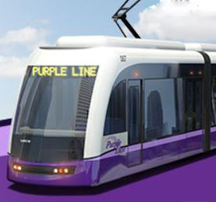Traffic Trends Do Not Show Any Benefit from Intercounty Connector
Presented by ACT President Tina Slater, July 17, 2013
Today I’d like to comment on the TPB Weekly Report of July 9, 2013 -- “Traffic-Related Delays Down Between 2010 and 2012, Study Finds.” The article compares the Washington Region’s traffic congestion to that of the newly opened Inter-County Connector (ICC). Here are some quotes from the article:
The TPB study found that travel conditions on local roads around the ICC saw greater improvements in travel conditions than the region as a whole.
Before the ICC opened in 2010, trips on roads in the surrounding area at peak hours took 43% to 45% longer than in free-flow conditions. By 2012, that number had fallen to around 30%. Increases in roadway capacity, like the ICC, surely contribute to such improvements.
As president of Action Committee for Transit, our group was interested in the article and concerned with the conclusions. It seems to state that there was dramatic reduction in congestion in the ICC Study Area once the ICC opened, as compared to the rest of the region. However, we aren’t sure that the TPB Weekly Report conclusion is correct ---it states that “increases in roadway capacity, like the ICC, surely contribute to such improvement.”
We think the bar graph shows a different explanation. Each bar graph (whether Washington Region or ICC Study Area) shows a roughly one-third decline in travel delays between 2010 and 2012. To us, it appears that whether you look at the region as a whole, or whether you focus on the ICC, there was a fairly consistent one-third decline in traffic throughout the region between 2010 and 2012. So perhaps the number reductions in the ICC area is not as important as the fact that it, too, declined by the same one-third as the region.
Our group wants to find ways to use existing infrastructure (which, BTW, we don't seem to have the money to maintain today) to move more *people*, rather than move more vehicles. Transportation is about moving people. WMATA was a bold project to move more people. We should be looking at ways to move masses of people (besides single-occupancy-vehicles, which seem to be the default mode when it comes to transportation planning). We would like to see more analysis of bus lanes for rapid transit vehicles, expanded commuter rail, and HOV lanes. Putting one person in one car and pouring more pavement for them will not meet the needs of expected population growth in the region.

